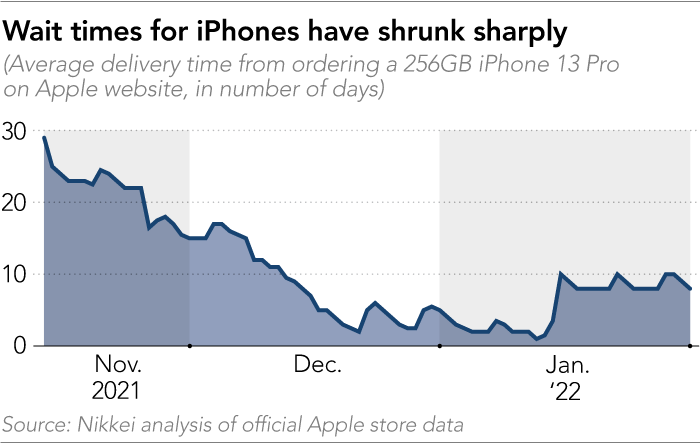[ad_1]
Consumers are still waiting up to nine weeks for delivery of new iPads, as Apple struggles to clear a backlog that emerged last year during the global chip and component crunch, according to Nikkei Asia’s analysis of more than two months of shipping data.
Nikkei Asia has been tracking the delivery times for Apple products in 25 key countries and regions, including the US, China and Japan, since early November. Customers ordering a new iPad (64GB model) on Apple’s website on January 28 faced an average wait of about 50 days, a slight improvement from the 55-day delivery times for iPad orders placed in early December.
Wait times for new iPhones, meanwhile, have shrunk dramatically, from more than a month late last year to about 10 days for some models.
Apple chief executive Tim Cook told investors on the latest earnings call that the iPad was the only product category that did not grow in the October to December quarter due to the supply constraints. “But overall we do see an improvement in the March quarter in terms of the constraints going down versus what they were in the December quarter,” he added.
Nikkei Asia’s latest analysis, however, shows that some Asian markets still face lengthy wait times. Consumers in the Philippines, for example, would have to wait up to 63 days if they ordered a space grey, 256GB iPad on January 28. For consumers in Malaysia, the wait time is around 54 days, the data indicate.
Apple has said the shortage of so-called legacy node chips has hit the iPad particularly hard, leading to revenue for the segment dropping 14.1 per cent on the year to $7.3bn in the three months through December. Legacy nodes are the less sophisticated semiconductors that handle tasks such as power management and display functions.

This article is from Nikkei Asiaa global publication with a uniquely Asian perspective on politics, the economy, business and international affairs. Our own correspondents and outside commentators from around the world share their views on Asia, while our Asia300 section provides in-depth coverage of 300 of the biggest and fastest-growing listed companies from 11 economies outside Japan.
“Since iPads have greater than 8-inch displays, they need a lot of display drivers and unfortunately display drivers are produced at legacy process nodes — which is at the core of the semiconductor supply crunch,” said Wayne Lam, senior director of research at CCS Insight, a London-headquartered research firm.
Despite a reputation as the world’s top procurement power, Apple was not able to avoid supply constraints last year as the global supply crunch hit a wide range of industries. To cope, the company began reallocating some shared components from the iPad line to the new iPhone 13 series to ensure smooth production of its flagship product ahead of the holiday season.
By early December, Apple saw signs of improvement in the supply chain and told iPhone assemblers to gear up production ahead of the Lunar New Year to meet consumer demand for the various holiday seasons around the world.

As a result, delivery times for the latest iPhones and Apple Watch have shortened significantly. For the 256GB iPhone 13 Pro, the delivery time on average for 25 key countries has shortened to about 10 days, Nikkei Asia’s analysis shows. This is down from around a month for orders placed in mid-November. Apple Watch 7 delivery times also fell to about 10 days from more than a month over the same period.
Differences in display types, not just size, are another factor in the diverging wait times, according to Lam, who pointed out that iPads use LCD displays, while iPhones and Apple Watches use more advanced OLEDs.
“LCD display drivers are heavily reliant on legacy silicon process nodes to produce,” Lam explained. “OLED displays tend to require less and use more advanced silicon processors.”
Compared to supplies of legacy node chips, those of advanced silicon processors are less constrained because of the relatively smaller demand and high priority that chipmakers place on their production because of the more lucrative returns.
A version of this article was first published by Nikkei Asia on February 2 2022. ©2022 Nikkei Inc. All rights reserved
Related stories
[ad_2]
Source link








